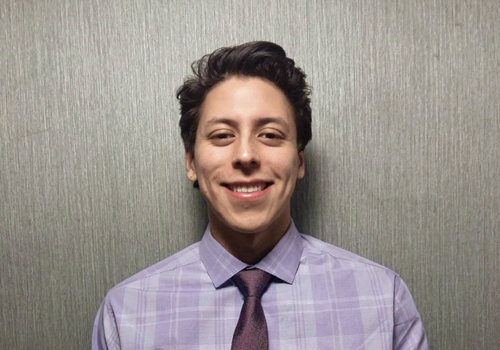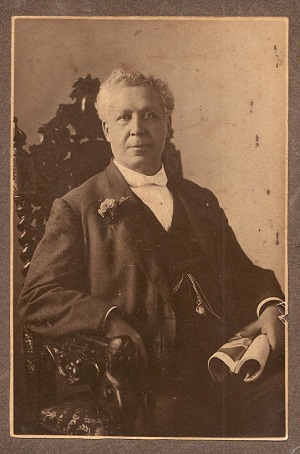Drew Rickard is still determining what, and what not, to share.
He’s part of a group of Indigenous U of T students and young adults from across the GTA who are currently being trained to lead virtual tours to celebrate the rich Indigenous history of the University’s three campuses and surrounding areas.
The third-year Arts & Science student and member of Woodsworth College majoring in philosophy — and exploring minors in either political science or Indigenous studies — is both excited and a little nervous. He’s never been a tour guide before.
“My interest in this is really in my identity and reconnecting with that,” says Rickard who is a member of the Cree First Nation. “I'm proud of who I am. This is a missing puzzle piece for something that I was already putting together — and so far it's been a great learning experience.”
The guides in training are encouraged to complement the historical information with their own personal knowledge and experiences, giving these tours added depth and substance.
That’s the part Rickard wrestles with.
“It's not easy to share who you are in an intimate way with people you don't know,” says Rickard, who plans on adding elements of his family history from Moose Factory, Ontario. “And some of the materials we deal with tends to be very sensitive and very charged.”

Set to begin this fall, the tours are part of an initiative from an ongoing partnership between the University of Toronto and First Story Toronto — an organization originally known as the Toronto Native Community History Project that is dedicated to researching and preserving the Indigenous history of Toronto and the surrounding region.
Jon Johnson, an assistant professor, teaching stream, at Woodsworth College, has been a part of First Story and the Toronto Native Community History Project for years. Johnson — who is mostly of French Canadian descent and has a small amount of Haudenosaunee and Kichisipirini ancestry — is overseeing the training along with Jill Carter, (Anishinaabe/Ashkenazi) an assistant professor with the Faculty of Arts & Science’s Centre for Drama, Theatre & Performance Studies.
The first cohort, including Rickard, will complete their training this summer with a second group set to begin their instruction later this fall, bringing the number of new guides to 17.
The new format will in no way lessen the impact of having Indigenous young adults lead the tours. They're going to bring a whole variety of perspectives and knowledges that may not be as visible in an older generation of guides — it's going to really energize the tours.
Originally, the plan was to have the guides give in-person tours, but the pandemic forced the tours to shift to an online format, with the guides using 360-degree video and other digital resources to host tours through programs like ZOOM or Microsoft Teams.
The new format will in no way lessen the impact of having Indigenous young adults lead the tours, says Johnson.
“They're going to bring a whole variety of perspectives and knowledges that may not be as visible in an older generation of guides,” he says. “It's going to really energize the tours.”
“Their stories, the lessons they draw from past teachings, the ways in which they have learned to read the land, and their experiences as young Indigenous people are crucial additions to First Story,” says Carter.
“These guides are working with Elders to recover the language of these territories, becoming intimate with buried histories, and gaining skills in oratory and digital storytelling,” she adds.
These skills and this experience will ultimately serve them well when pursuing future academic and professional goals, says Carter.
There are a lot of themes of identity loss and retrieval and I think having people from the communities is not only a way of addressing that, it will also make the participants’ experience that much more real.
“Soon, they will meet faculty and fellow students across departments and disciplines as they conduct tours,” she says. “Who knows what opportunities such encounters may open up for them?”
For Rickard, leading these tours is an opportunity to better connect with his own roots, while bringing the historical information to life, with he and the other guides being the embodiment of Indigenous peoples’ past.
“There are a lot of themes of identity loss and retrieval and I think having people from the communities is not only a way of addressing that, it will also make the participants’ experience that much more real,” says Rickard.
Still, he has no intention of trying to persuade anyone’s thinking or opinions. “I think it's important to allow someone to come to their own conclusions. I think that has more staying power than telling someone what something definitively is.”
Tours highlight rich Indigenous history across U of T

The First Story virtual tours highlight the rich Indigenous history across all three of U of T campuses. Each offers a glimpse into a vibrant time in the country’s Indigenous peoples’ past. Here is an example from each campus:
St. George Campus
In 1867, a young Kanien'kehá:ka (Mohawk) man by the name of Oronyhatekha (‘Burning Sky’) earned a degree in medicine from U of T, becoming the second First Nations person to attain a medical degree in Canada. Practicing medicine for many years in Southern Ontario communities, Oronhyatekha was also a champion Indigenous rights and social justice. His letters were published in newspapers and his ideas informed the creation of federal legislation that, from 1885-1896, allowed First Nations people to vote in Canadian elections.
University of Toronto Mississauga
The Credit River, which flows just west of the campus, is derived from the Mississauga name for this river, ‘Missinihe’ which many interpret to mean ‘trusting water.’ The Mississaugas established a village at the mouth of the Credit that was inhabited until about 1751. Prominent in the fur trade in the Toronto area, it became common practice to extend credit to First Nations trappers so that they could purchase necessary supplies ahead of trapping excursions. The Mississaugas were known for always paying back the credit extended to them, leading to the inspiration for the name, ‘Credit River’.
University of Toronto Scarborough
The UTSC campus is located at the edge of what was once the biggest pine savanna in the Toronto region, encompassing much of what is now Rouge Park. Indigenous peoples in this area often maintained savanna areas through controlled burns, enabling the land to be used in multiple ways. As a result, this area provided plant medicines, attracted animals for hunting and were used as gardens. It’s likely that Mississauga, Seneca and Wendat peoples, at different times, employed controlled burns to maintain savannas, making the area of UTSC well-travelled and well-used by Indigenous peoples.
Sign up for a tour
To sign up for a First Story tour this fall, class instructors or organizations can contact First Story tour administrator, Audrey Rochette at firststorytoronto@gmail.com.

